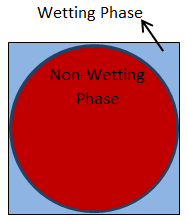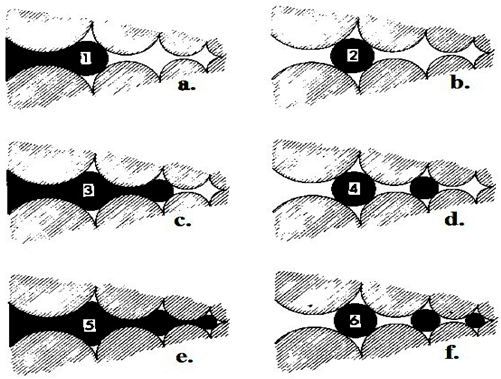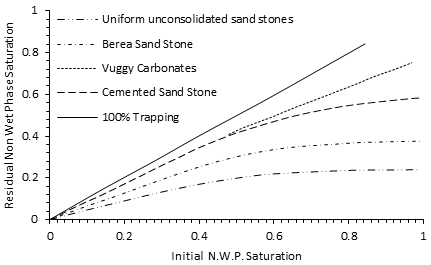Fundamentals of Fluid Flow in Porous Media
Chapter 2
Multi-phase Saturated Rock Properties:
Phase Trapping: Snap-Off
Consider a square capillary into which a non-wetting phase has entered (Figure 2‑65). The capillary pressure at which the non-wetting fluid first enters the square capillary is approximately

Suppose now the wetting phase is allowed to flow back along the corners without the end of the drop exiting the capillary. If the capillary pressure is now then decreased below Pcso, the capillary pressure of a cylindrical filament that just touches the capillary walls,

Figure 2-65: Non-Wetting Fluid Enters a Capillary Tube with Square Cross Section


Figure 2-66: Side View After Snap-Off (Cross Section From Middle of Square)
Now consider a porous media instead of the capillary tube. Suppose the porous medium is made up of pore bodies and pore necks of many different sizes as shown in Figure 2‑67. The medium is initially saturated with the wetting phase. The non-wetting phase is first allowed to enter only the largest pores as in Figure 2‑67.a and then the capillary pressure reduced to zero. Non-wetting phase will be trapped as in Figure 2‑67.b. With additional cycles with increasing initial non-wetting saturation additional trapping will occur as in Figure 2‑67.d and Figure 2‑67.f. according to the previous definition the process in Figure 2‑67.a,c,e are drainage and Figure 2‑67.b,d,f are imbibition.
Such an experiment with increasing initial saturation of the non-wetting phase saturation measuring the residual saturation at each initial saturation generates an initial – residual saturation curve as in Figure 2‑68. This curve probes the volume of non-wetting phase trapping sites as a function of entering increasingly finer pores. This curve can be used to determine the saturation of non-wetting phase that is trapped at a given saturation if information is available on the maximum non-wetting saturation attained, i.e., memory of its history is available[2]. BYPASSING >> If you have any questions at all, please feel free to ask PERM! We are here to help the community.
Figure 2-67: Trapping in a Porous Media
Figure 2-68: Typical Non-Wetting Phase Trapping Characteristics of Some Reservoir Rocks[3]References
Questions?
